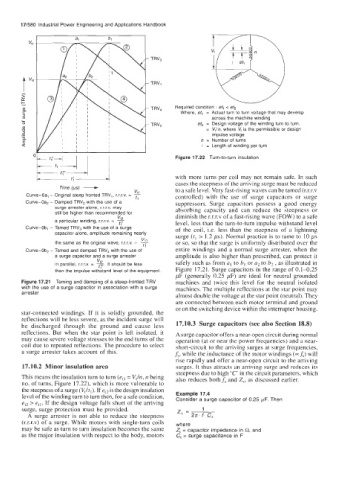Page 615 - Industrial Power Engineering and Applications Handbook
P. 615
17/580 Industrial Power Engineering and Applications Handbook
TRV3
TRV,
TRV, Required condition : etl < et,
Where, etl = Actual turn to turn voltage that may develop
across the machine winding
TRV, et, = Design voltage of the winding turn to turn.
= VJn, where V, is the permissible or design
impulse voltage
n = Number of turns
= Length of winding per turn
Figure 17.22 Turn-to-turn insulation
with more turns per coil may not remain safe. In such
cases the steepness of the arriving surge must be reduced
to a safe level. Very fast-rising waves can be tamed (r.r.r.v
“1 1
Curve-Oa, - Original steep fronted TRV,, r.r.r.v. = - controlled) with the use of surge capacitors or surge
tl
Curve-Oa2 - Damped TRV, with the use of a suppressors. Surge capacitors possess a good energy
surge arrester alone, r.r.r.v. may absorbing capacity and can reduce the steepness or
still be higher than recommended for
v,, diminish the r.r.r.v of a fast-rising wave (FOW) to a safe
a particular winding, r.r.r.v. = 7 level, less than the turn-to-turn impulse withstand level
ti
Curve-Ob, - Tamed TRV3 with the use of a surge of the coil, i.e. less than the steepness of a lightning
capacitor alone, amplitude remaining nearly surge (t, > 1.2 ps). Normal practice is to tame to 10 ps
Vtl
the same as the original wave, r.r.r.v. - or so, so that the surge is uniformly distributed over the
ti
Curve-Ob, - Tamed and damped TRV, with the use of entire windings and a normal surge arrester, when the
a surge capacitor and a surge arrester amplitude is also higher than prescribed, can protect it
vi,
in parallel, r.r.r.v. = - It should be less safely such as from a, to bl or uz to b2 , as illustrated in
t;”’
than the impulse withstand level of the equipment Figure 17.21. Surge capacitors in the range of 0.1-0.25
pF (generally 0.25 pF) are ideal for neutral grounded
Figure 17.21 Taming and damping of a steep-fronted TRV machines and twice this level for the neutral isolated
with the use of a surge capacitor in association with a surge machines. The multiple reflections at the star point may
arrester
almost double the voltage at the star point (neutral). They
are connected between each motor terminal and ground
or on the switching device within the interrupter housing.
star-connected windings. If it is solidly grounded, the
reflections will be less severe, as the incident surge will
be discharged through the ground and cause less 17.10.3 Surge capacitors (see also Section 18.8)
reflections. But when the star point is left isolated, it A surge capacitor offers a near-open circuit during normal
may cause severe voltage stresses to the end turns of the operation (at or near the power frequencies) and a near-
coil due to repeated reflections. The procedure to select short-circuit to the arriving surges at surge frequencies,
a surge arrester takes account of this. A, while the inductance of the motor windings (-fJ will
rise rapidly and offer a near-open circuit to the arriving
17.10.2 Minor insulation area surges. It thus attracts an arriving surge and reduces its
steepness due to high ‘C’ in the circuit parameters, which
This means the insulation turn to turn (etl = VJn, n being also reduces both f, and Z,, as discussed earlier.
no. of turns, Figure 17.22), which is more vulnerable to
the steepness of a surge ( Vt/tl). If e,2 is the design insulation
level of the winding turn to turn then, for a safe condition, Example 17.4
et2 > etl. If the design voltage falls short of the arriving Consider a surge capacitor of 0.25 pF. Then
surge, surge protection must be provided.
A surge arrester is not able to reduce the steepness
(r.r.r.v) of a surge. While motors with single-turn coils where
may be safe as turn to turn insulation becomes the same Z, = capacitor impedance in R, and
as the major insulation with respect to the body, motors C, = surge capacitance in F

